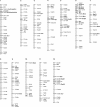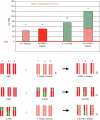Domestication and breeding of tomatoes: what have we gained and what can we gain in the future?
- PMID: 17717024
- PMCID: PMC2759208
- DOI: 10.1093/aob/mcm150
Domestication and breeding of tomatoes: what have we gained and what can we gain in the future?
Abstract
Background: It has been shown that a large variation is present and exploitable from wild Solanum species but most of it is still untapped. Considering the thousands of Solanum accessions in different gene banks and probably even more that are still untouched in the Andes, it is a challenge to exploit the diversity of tomato. What have we gained from tomato domestication and breeding and what can we gain in the future?
Scope: This review summarizes progress on tomato domestication and breeding and current efforts in tomato genome research. Also, it points out potential challenges in exploiting tomato biodiversity and depicts future perspectives in tomato breeding with the emerging knowledge from tomato-omics.
Conclusions: From first domestication to modern breeding, the tomato has been continually subjected to human selection for a wide array of applications in both science and commerce. Current efforts in tomato breeding are focused on discovering and exploiting genes for the most important traits in tomato germplasm. In the future, breeders will design cultivars by a process named 'breeding by design' based on the combination of science and technologies from the genomic era as well as their practical skills.
Figures



References
-
- Alpert KB, Grandillo S, Tanksley SD. fw 2·2: a major QTL controlling fruit weight is common to both red- and green-fruited tomato species. Theoretical and Applied Genetics. 1995;91:994–1000. - PubMed
-
- Bai Y, Lindhout P. New Challenges for Durable Resistance Breeding in Tomato. Proceedings of the XVth meeting of the Eucarpia Tomato Working Group; 20–23 September, 2005; Bari, Italy. 2005.
-
- Bai Y, Huang CC, Van der Hulst R, Meijer-Dekens F, Bonnema G, Lindhout P. QTLs for tomato powdery mildew resistance (Oidium lycopersici) in Lycopersicon parviflorum G1·1601 co-localize with two qualitative powdery mildew resistance genes. Molecular Plant Microbe Interaction. 2003;16:169–176. - PubMed
-
- Bai Y, Feng X, Van der Hulst R, Lindhout P. A set of simple PCR markers converted from sequence specific RFLP markers on tomato chromosomes 9 to 12. Molecular Breeding. 2004;13:281–287.
Publication types
MeSH terms
LinkOut - more resources
Full Text Sources
Other Literature Sources

